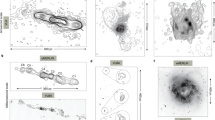Abstract
ALL radio observational work on OH has so far been concentrated on previously known astronomical objects. Initially the OH microwave radiation was found absorbed in the spectra of strong continuum sources1, but in the search for more OH absorption lines weaker and weaker continuum sources were investigated. The guide in this search was the source catalogue made by Westerhout2, which contains sources around the galactic plane measured at the frequency 1,390 MHz. Many of these sources have a thermal spectrum and therefore are associated with H II regions. Because the first OH emission sources were found in or near some of these H II regions3,4, the search for more OH emission was carried out chiefly on thermal radio sources. Many new OH emission sources were found in this way and theories of maser action in OH associated with H II regions were produced5,6.
This is a preview of subscription content, access via your institution
Access options
Subscribe to this journal
Receive 51 print issues and online access
$199.00 per year
only $3.90 per issue
Buy this article
- Purchase on Springer Link
- Instant access to full article PDF
Prices may be subject to local taxes which are calculated during checkout
Similar content being viewed by others
References
Weinreb, S., Barrett, A. H., Meeks, M. L., and Henry, J. C., Nature, 200, 829 (1963).
Westerhout, G., Bull. Astro. Inst. Ned., 14, 215 (1958).
Gundermann, E., thesis, Harvard Univ. (1965).
Weaver, H., Williams, D. R. W., Dieter, N. H., and Lum, W. T., Nature, 208, 29 (1965).
Perkins, F., Gold, T., and Salpeter, E. E., Astrophys. J., 145, 361 (1966).
Cook, A. H., Nature, 210, 611 (1966).
Raimond, E., and Eliasson, B., Astrophys. J., 150, L171 (1967).
Becklin, E. E., and Neugebauer, G., Astrophys. J., 147, 799 (1967).
Mezger, P. G., Altenhoff, W., Schraml, J., Burke, B. F., Reifenstein III, E. C., and Wilson, T. L., Astrophys. J., 150, L157 (1967).
Reddish, V. C., Mon. Not. Roy. Astro. Soc., 135, 251 (1967).
Wilson, W. J., and Barrett, A. H., Science, 161, 778 (1968).
Neugebauer, G., Martz, D. E., and Leighton, R. B., Astrophys. J., 142, 399 (1965).
Kollberg, E., and Rydbeck, O. E. H., IEEE Trans. Microw., MTT-16, 799 (1968).
Elldér, J., Res. Lab. Electronics, Chalmers Univ. of Tech., Res. Rep. No. 87 (1968).
IAU Inform. Bull., No. 11 (1963).
Ball, J. A., and Staelin, D. H., Astrophys. J., 153, L41 (1968).
Downes, D., and Rinehart, R., Astrophys. J., 144, 937 (1966).
Author information
Authors and Affiliations
Rights and permissions
About this article
Cite this article
ELLDÉR, J., RÖNNÄNG, B. & WINNBERG, A. New OH Radio Emission Sources in Cygnus. Nature 222, 67–69 (1969). https://doi.org/10.1038/222067a0
Received:
Issue Date:
DOI: https://doi.org/10.1038/222067a0
This article is cited by
-
A classification of the available astrophysical data of particular Hii regions
Astrophysics and Space Science (1976)
-
Compact Radio Source Associated with the OH Source ON-1 (OH69.5–1.0)
Nature Physical Science (1973)
-
Two Infrared Sources in Nebulae
Nature (1970)
Comments
By submitting a comment you agree to abide by our Terms and Community Guidelines. If you find something abusive or that does not comply with our terms or guidelines please flag it as inappropriate.



